Imagine transforming your backyard into a captivating retreat where alfresco dining becomes a cherished ritual. Whether you’re a novice in outdoor design or a seasoned homeowner with a flair for style, the right pergola can redefine your dining area, blending functionality with flair. Embracing the charm of outdoor living, pergolas provide both shade and structure, allowing you to enjoy meals beneath a canopy of elegance.
In this article, you’ll discover twelve inspiring pergola designs that cater to a variety of tastes and needs, from minimalist modern to lush and rustic. You’ll gain practical insights into selecting the perfect design that complements your home and elevates your outdoor space. Prepare to unlock the potential of your backyard and create a dining area where cherished memories are made under the open sky.
Classic Wooden Pergola Charm
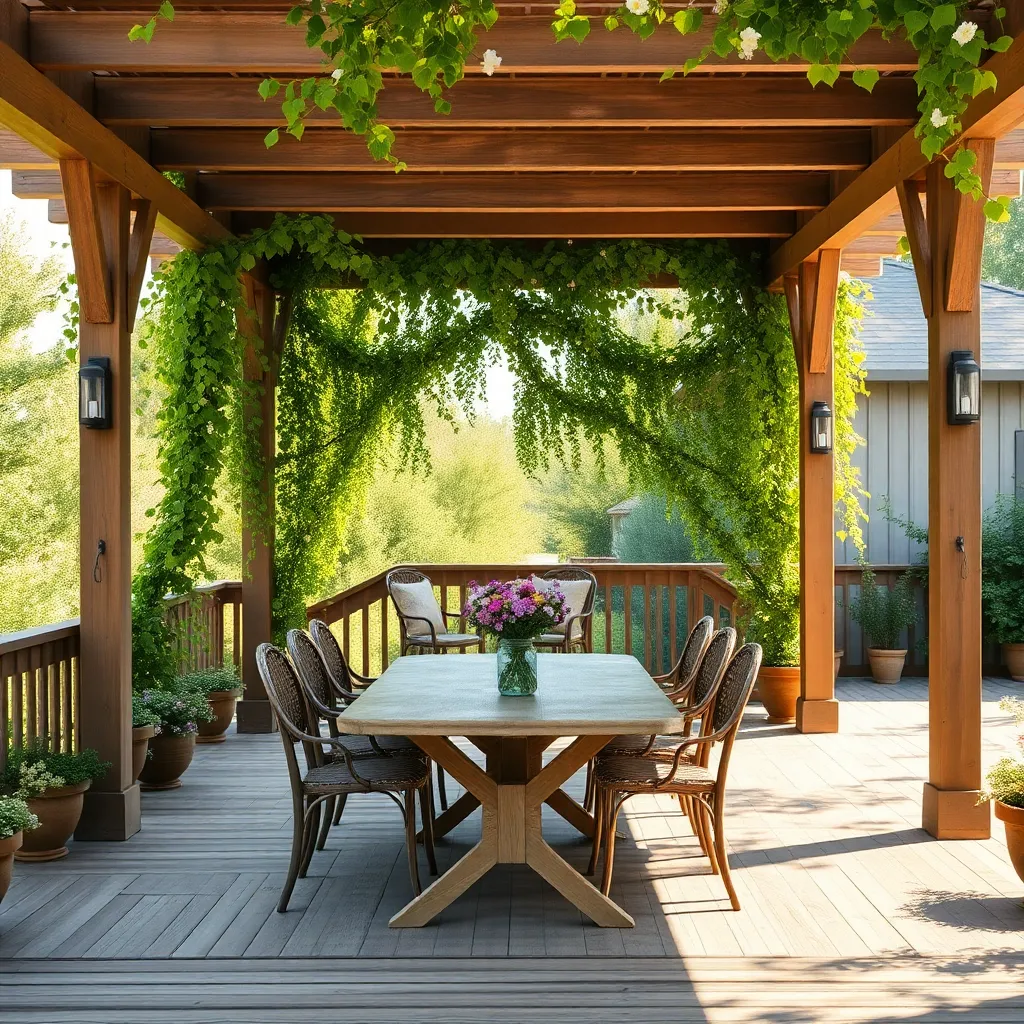
Embrace the timeless appeal of a classic wooden pergola to create an inviting outdoor dining space. Choosing durable woods like cedar or redwood not only ensures longevity but also adds a touch of natural beauty to your garden. For beginners, a simple rectangular design with a height of about 8-10 feet provides ample space and shade, perfect for accommodating a dining table and chairs. Consider using pressure-treated wood for the posts and beams to resist rot and insect damage, ensuring your pergola stands the test of time.
To add charm and functionality, incorporate decorative elements like latticework or climbing plants. Advanced gardeners might experiment with integrating built-in planters or lighting for evening ambiance.
- Install horizontal slats across the top for partial shade, which can also host climbing vines like wisteria or grapevines.
- Enhance the aesthetic with weather-resistant stains or paints that match your outdoor decor.
Whether you’re dining al fresco or hosting a gathering, a classic wooden pergola effortlessly transforms your backyard into a cozy retreat.
Modern Metal Pergola Designs
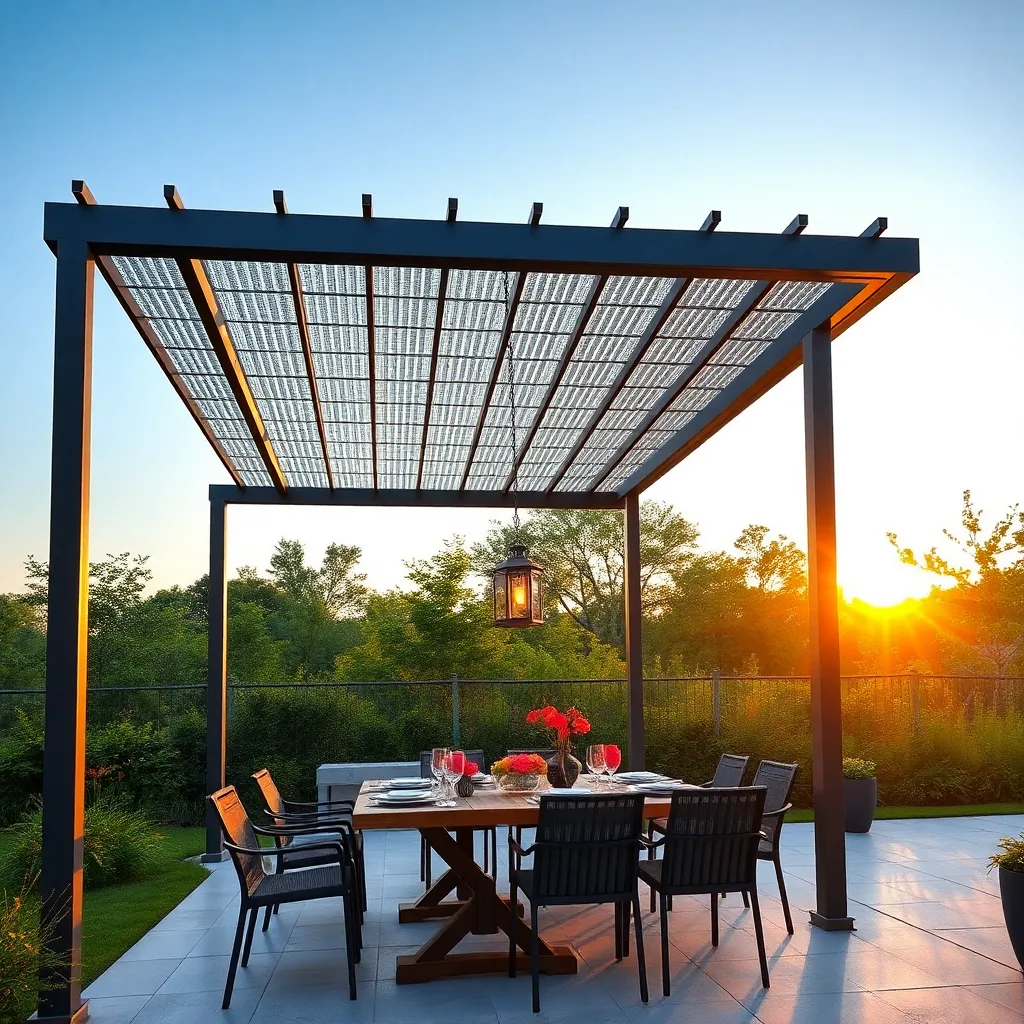
Modern metal pergolas offer a sleek and durable addition to any outdoor dining area, combining functionality with contemporary aesthetics. For those new to metal pergolas, consider using materials like aluminum or steel, as they are both lightweight and resistant to rust, making them ideal for various climates. These structures can be customized with powder-coated finishes in colors ranging from classic black to muted earth tones, allowing homeowners to match their existing outdoor decor seamlessly.
Advanced DIY enthusiasts might explore incorporating integrated lighting or motorized louvered roofs for added convenience and ambiance. When planning your design, ensure the pergola dimensions are proportionate to your dining area; a typical recommendation is to leave at least two feet of overhang on all sides of your dining table. For a more sophisticated touch, consider adding side panels or adjustable screens to provide privacy and wind protection, enhancing the overall dining experience. By selecting quality materials and thoughtful design elements, your metal pergola will not only elevate your outdoor space but also offer a lasting retreat for relaxation and entertainment.
Rustic Pergola with Natural Elements
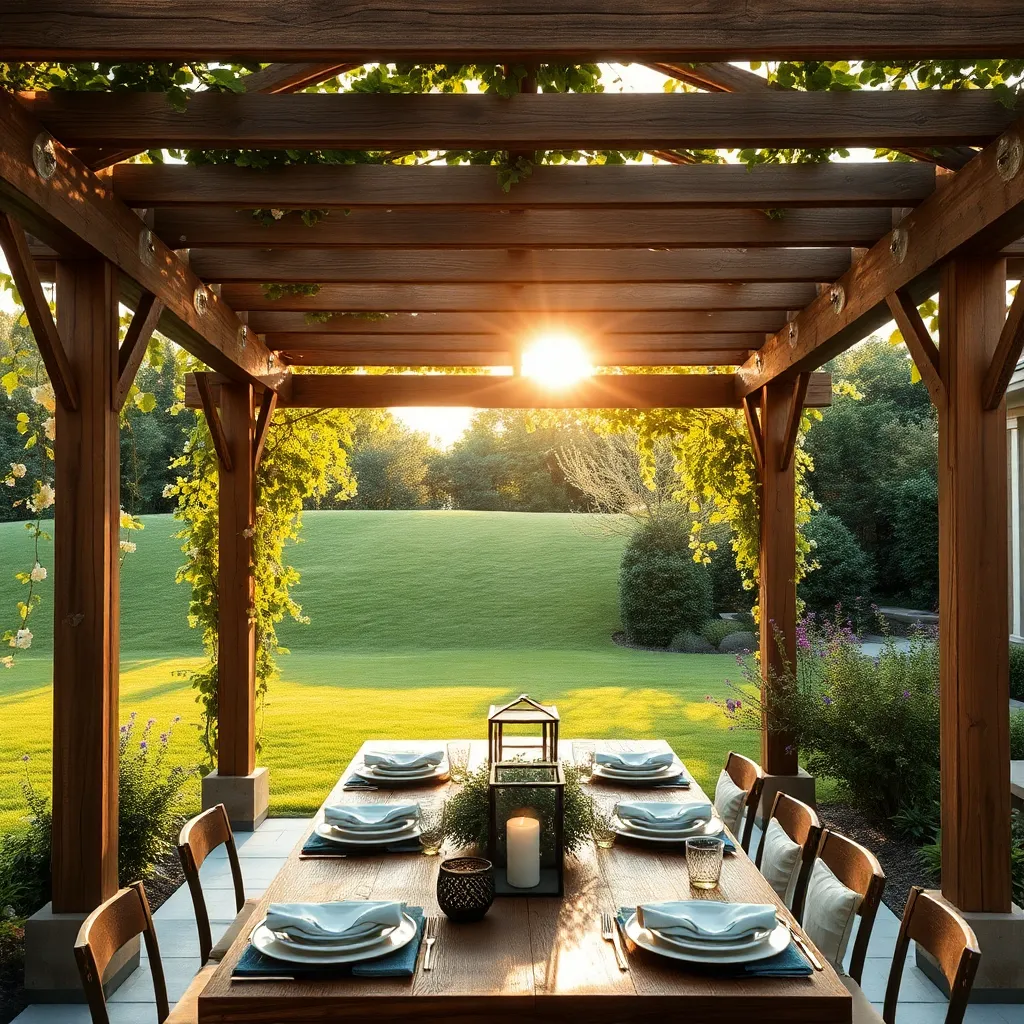
Transforming your backyard into a cozy dining area can be beautifully achieved with a rustic pergola that emphasizes natural elements. Begin by selecting robust timbers like cedar or redwood, known for their durability and resistance to the elements. These woods not only offer longevity but also a warm, natural aesthetic that enhances any outdoor space. To amplify the rustic charm, consider incorporating reclaimed wood for crossbeams or decorative accents. This not only adds character but is also an environmentally friendly choice.
For a truly inviting atmosphere, weave in natural elements such as climbing plants or vines like wisteria or honeysuckle. These plants can create a lush, green canopy that provides shade and a sense of enclosure. As you design, remember to allow for sufficient spacing between beams to support plant growth while ensuring stability. For an added touch, string fairy lights or lanterns along the beams to create a magical ambiance for evening gatherings. By focusing on these natural, rustic elements, your pergola will become a stunning focal point in your outdoor dining area.
Mediterranean Style Pergolas
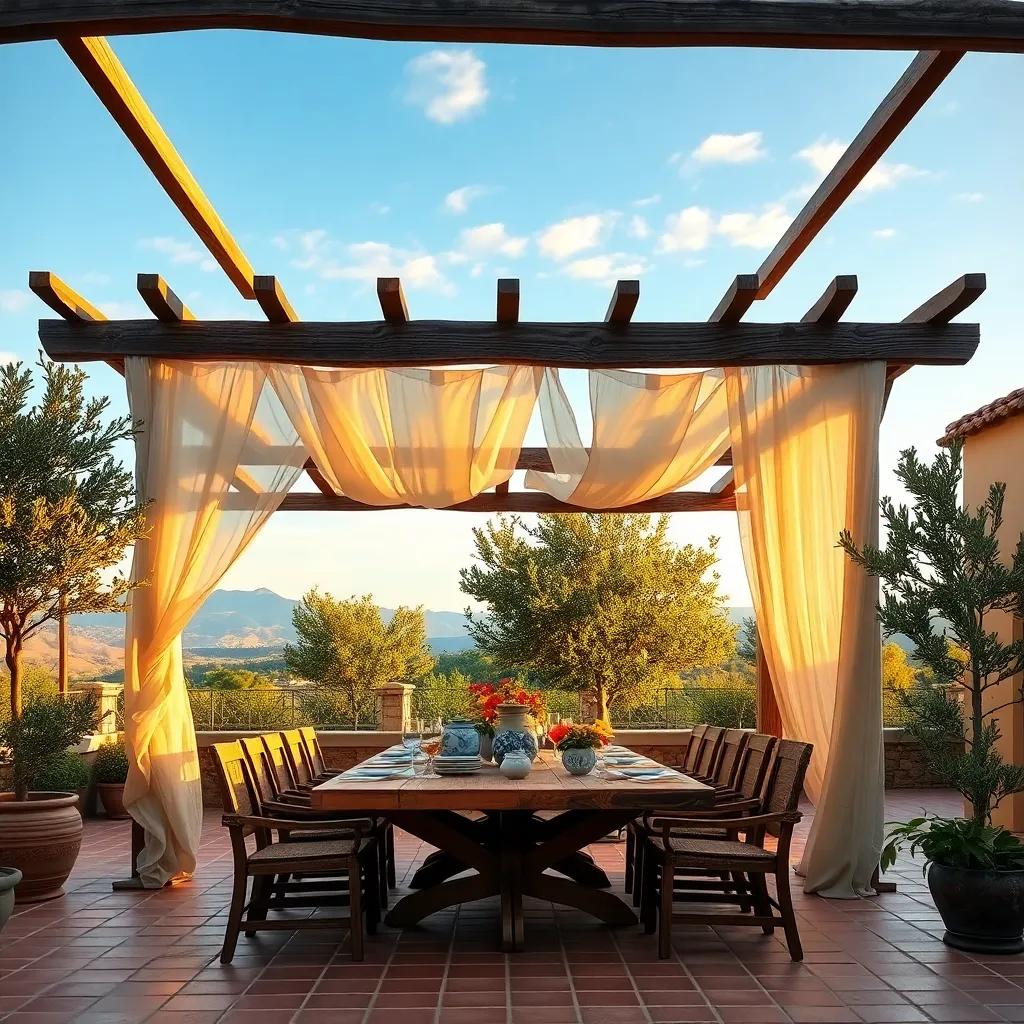
Mediterranean-style pergolas bring a touch of the sun-drenched coast to your backyard, offering both elegance and functionality. To achieve this look, consider using natural materials such as weathered wood or wrought iron for the frame, paired with terracotta or stone accents. These materials not only provide durability but also enhance the aesthetic appeal. For beginners, starting with a simple rectangular design and gradually adding intricate elements like curved beams or decorative metalwork can be a rewarding project.
Incorporate climbing plants like bougainvillea or jasmine to add color and fragrance, creating a lush canopy that provides shade during warm months. Advanced gardeners might explore adding retractable canopies or adjustable louvered roofs to control sunlight exposure. When selecting materials, ensure they are treated for weather resistance to extend the life of your pergola. Remember, the key to a Mediterranean pergola is in the details—think about adding ornate lanterns or outdoor drapery for a truly authentic feel.
Minimalist Pergola for Sleek Spaces
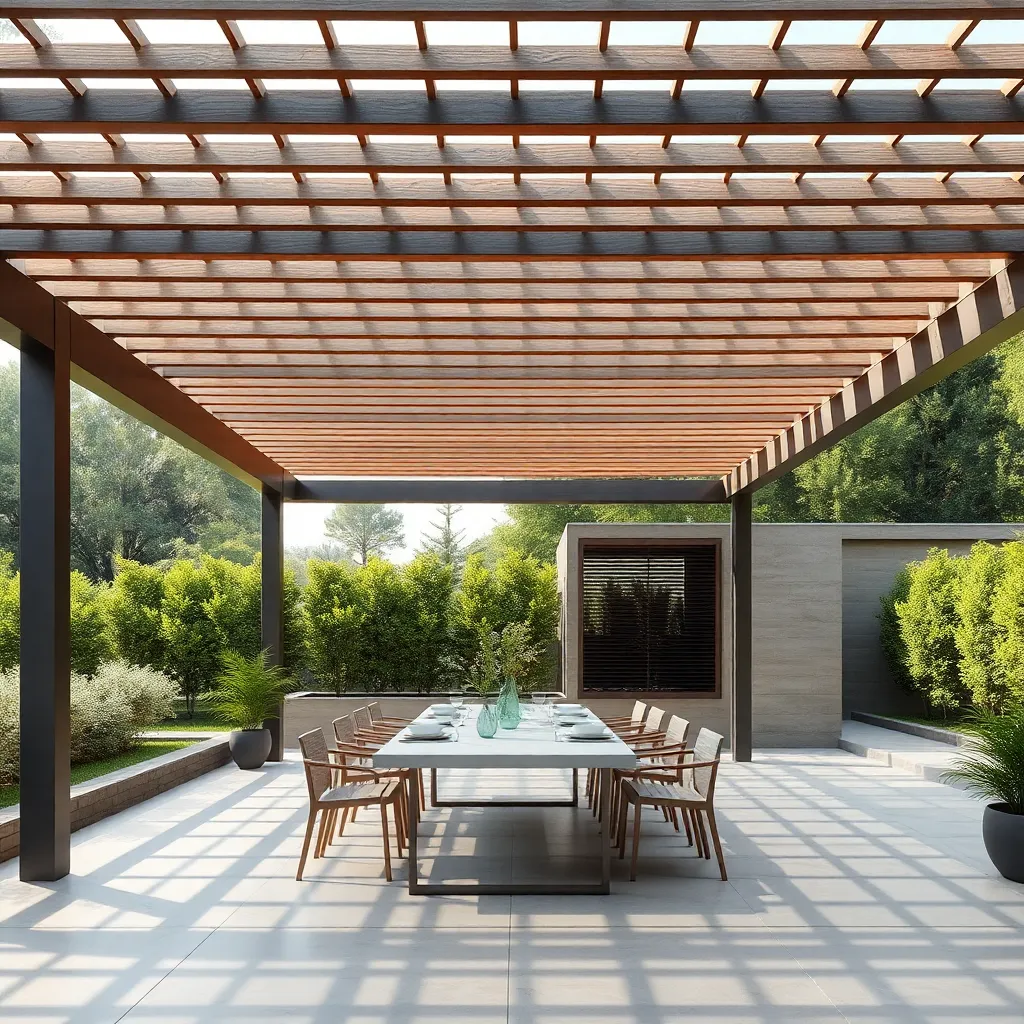
A minimalist pergola is perfect for those seeking a sleek and understated design that complements modern outdoor spaces. To achieve this look, choose materials like powder-coated aluminum or steel, which provide a clean, contemporary finish and require minimal maintenance. Opt for a simple, linear design with straight beams and open sides to enhance the minimalist aesthetic while allowing for ample light and airflow.
Installing a minimalist pergola can be straightforward with the right approach. Ensure the structure is well-proportioned to your space by maintaining a height of at least 7 feet and selecting a width that aligns with your outdoor dining area. For those with advanced DIY skills, consider integrating lighting elements or retractable canopies to add functionality without compromising on style. Anchor the pergola securely using concrete footings to ensure stability and longevity, especially in areas prone to high winds.
Pergola with Integrated Lighting
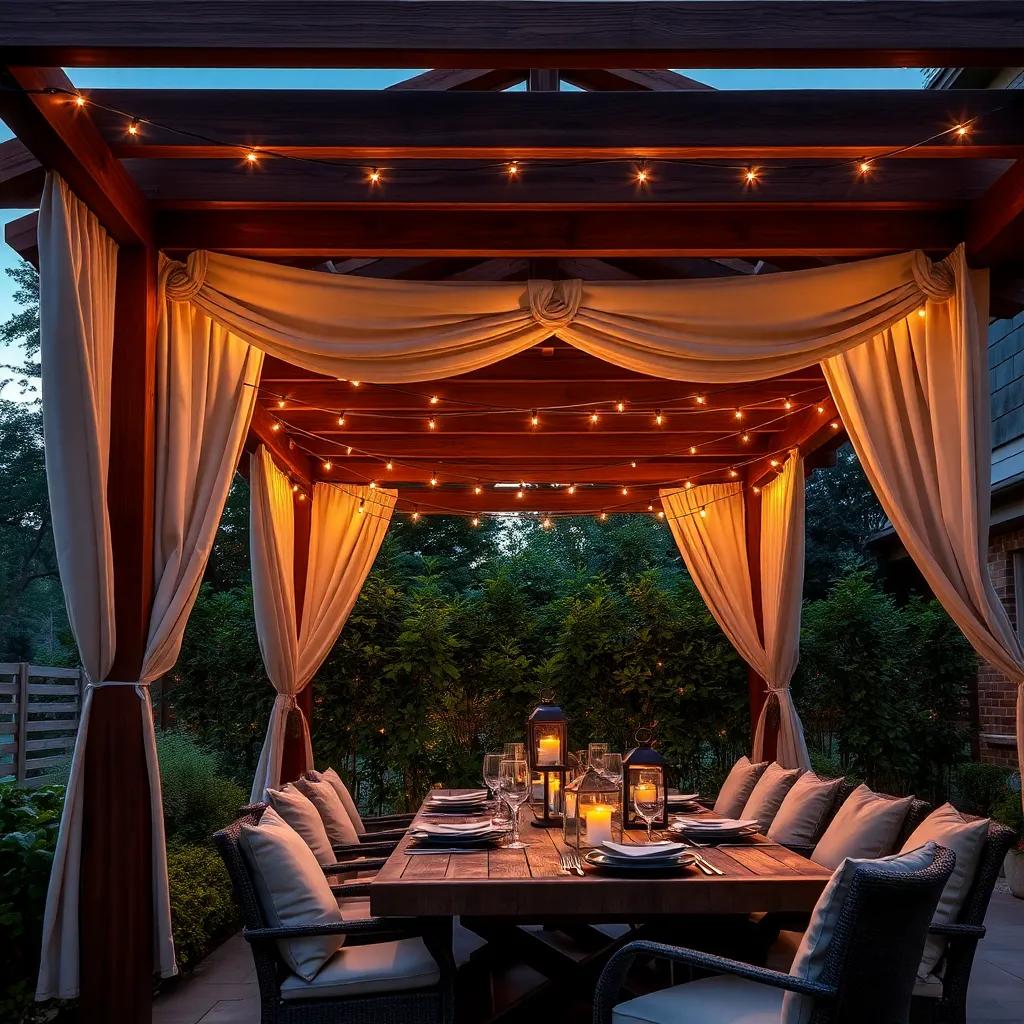
Integrating lighting into your pergola design can transform it into a magical evening dining space. Consider using weather-resistant LED string lights or recessed spotlights built into the structure for a subtle yet stunning effect. An easy installation tip is to use adjustable cable ties or hooks to avoid drilling into the pergola beams, preserving the wood’s integrity. For those looking for a more advanced setup, consider installing a smart lighting system that allows you to control brightness and color, enhancing the mood with just a tap on your smartphone.
When selecting materials, opt for pressure-treated wood or aluminum to withstand varying weather conditions, ensuring your pergola remains sturdy and durable. If you’re a beginner, start with a simple design that utilizes a rectangular framework, as this provides a straightforward method for integrating lighting. Advanced DIY enthusiasts might explore custom designs, incorporating features like built-in planters or benches to utilize space effectively. Always prioritize safety by ensuring all electrical components are rated for outdoor use, and consult with a professional if undertaking complex electrical work.
Eco-Friendly Pergola Materials
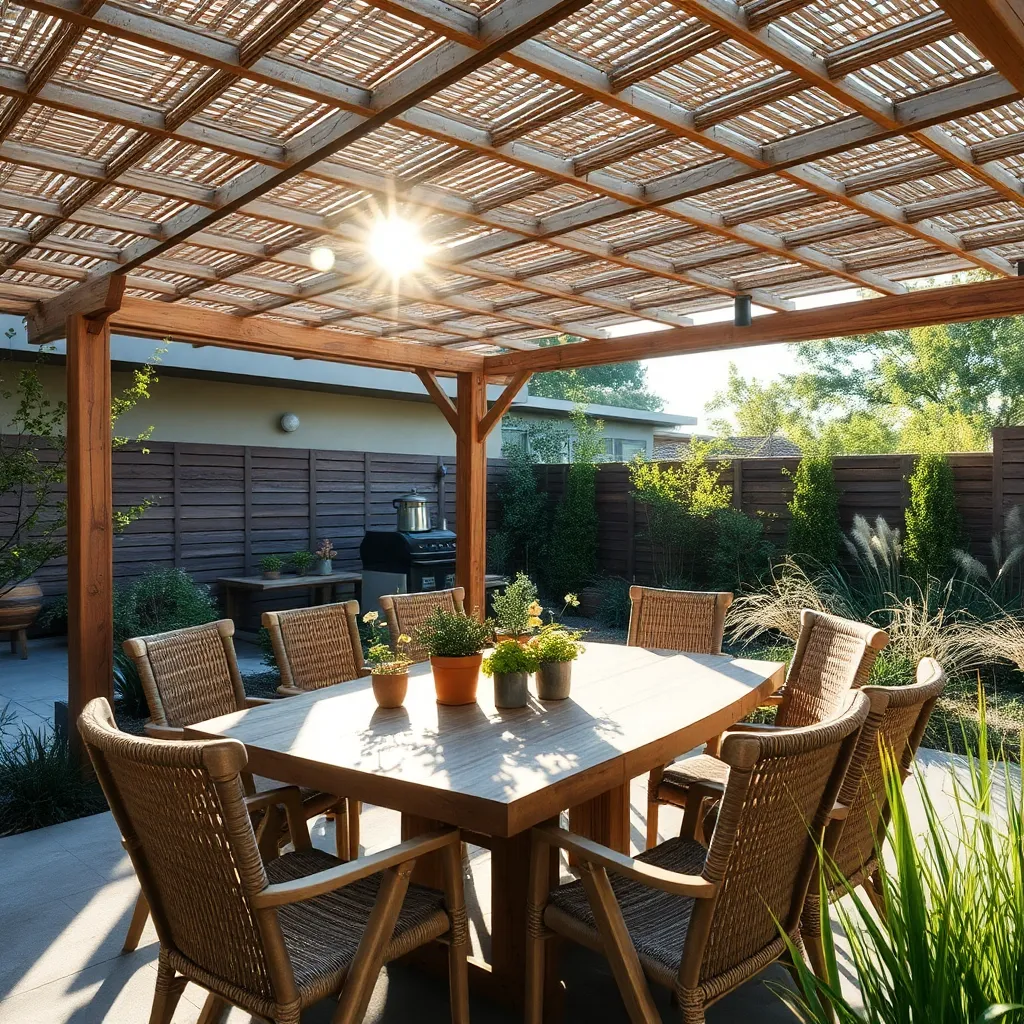
For an eco-friendly pergola, consider using sustainable materials like bamboo, reclaimed wood, or recycled metal. Bamboo is a fast-growing renewable resource that offers a natural aesthetic, while reclaimed wood adds character and reduces waste. Opt for recycled metal for a modern look that is durable and easy to maintain. When selecting materials, ensure they are treated to withstand local weather conditions, which will extend the lifespan of your pergola.
Incorporating eco-friendly design elements can enhance both the functionality and sustainability of your pergola. Install a green roof or climbing plants to provide natural shade and improve air quality. For added eco-benefits, use water-based, non-toxic finishes to protect the materials without harming the environment. Advanced gardeners might consider integrating a rainwater collection system into the pergola design to support surrounding garden areas. These thoughtful touches not only make your outdoor dining area more inviting but also contribute to a healthier planet.
Pergola with Adjustable Roofing
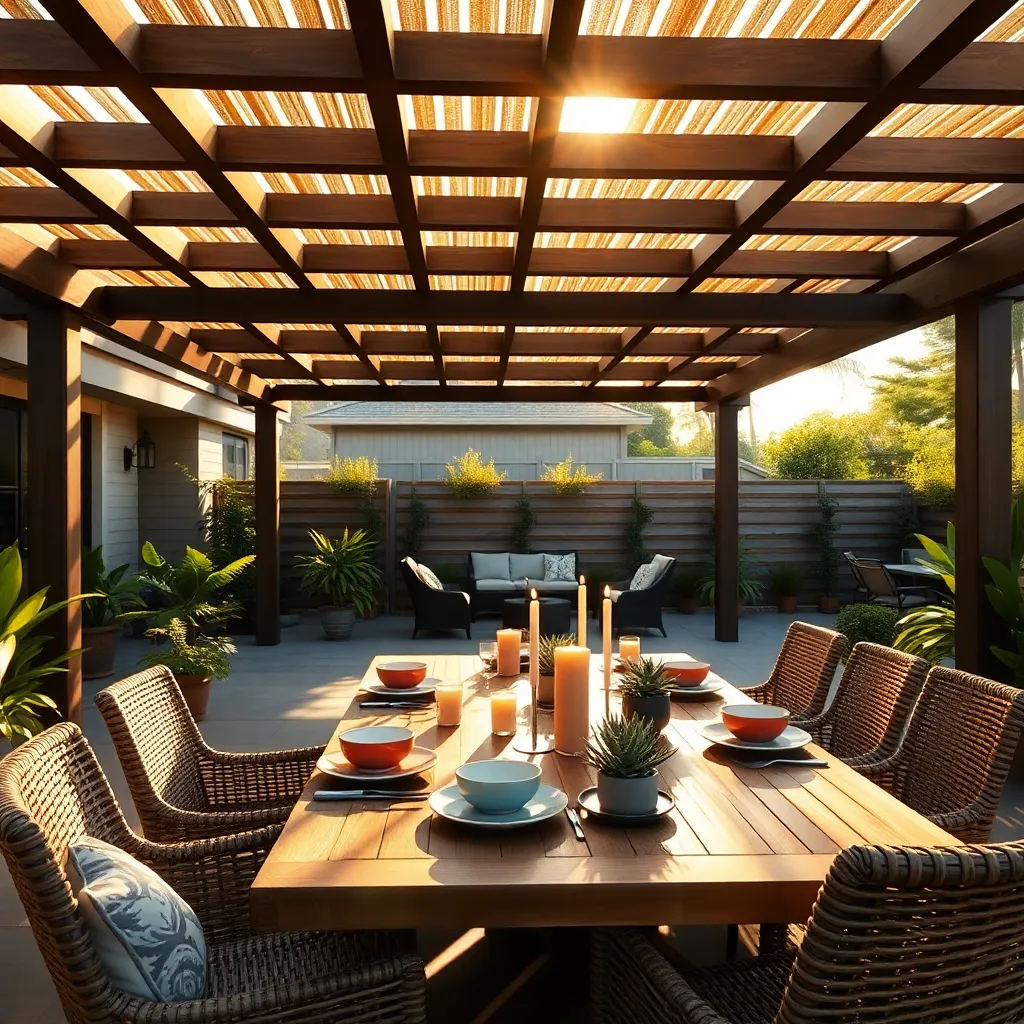
Transform your outdoor dining area into a versatile retreat with a pergola featuring an adjustable roofing system. This innovative design allows you to control the amount of sunlight or shade your space receives, making it ideal for all seasons. Adjustable louvers, often made from durable materials like aluminum, can be tilted to block out harsh sun rays or opened to let in a gentle breeze. For those seeking a DIY approach, consider prefabricated kits that offer easy assembly and customization options.
Enhance functionality by integrating weather-resistant fabrics into your pergola’s design. Retractable canopies are an excellent choice, providing additional protection from unexpected rain while keeping the area cool during hot days. Advanced users might explore motorized systems that can be controlled via remote or smart devices for added convenience. When planning your pergola’s size, ensure it complements your dining set, typically allowing for at least 10×10 feet to accommodate a table and chairs comfortably. With the right materials and design, your adjustable pergola will become the centerpiece of your outdoor gatherings.
Space-Saving Pergola Solutions
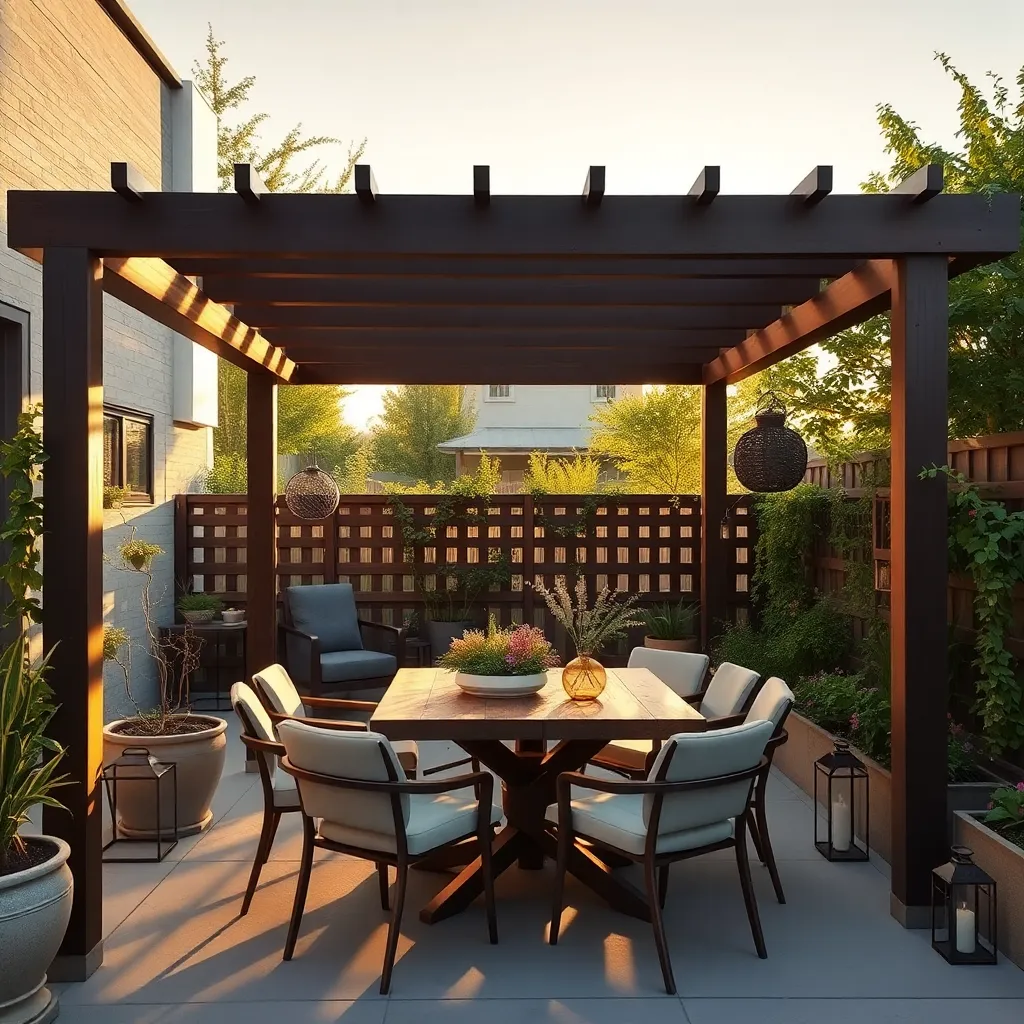
For homeowners with limited backyard space, a **compact pergola** can transform a small area into an inviting dining nook. Opt for a **corner pergola** design that fits snugly against two walls, maximizing usable space without overwhelming your yard. Use lightweight, durable materials like aluminum or cedar that are easy to maintain and can withstand various weather conditions. For added functionality, consider integrating built-in seating or a foldable table to make the most of your compact area.
Implementing **vertical elements** can further enhance your space-saving pergola. Install lattice or trellis panels on one or two sides to support climbing plants like jasmine or clematis, which can provide natural shade and privacy. If you’re feeling ambitious, include a retractable canopy or sunshade to adjust coverage according to the time of day. **Advanced DIYers** might explore modular pergola kits, offering flexibility and ease of assembly, allowing you to customize dimensions to fit any space.
DIY Pergola Construction Tips
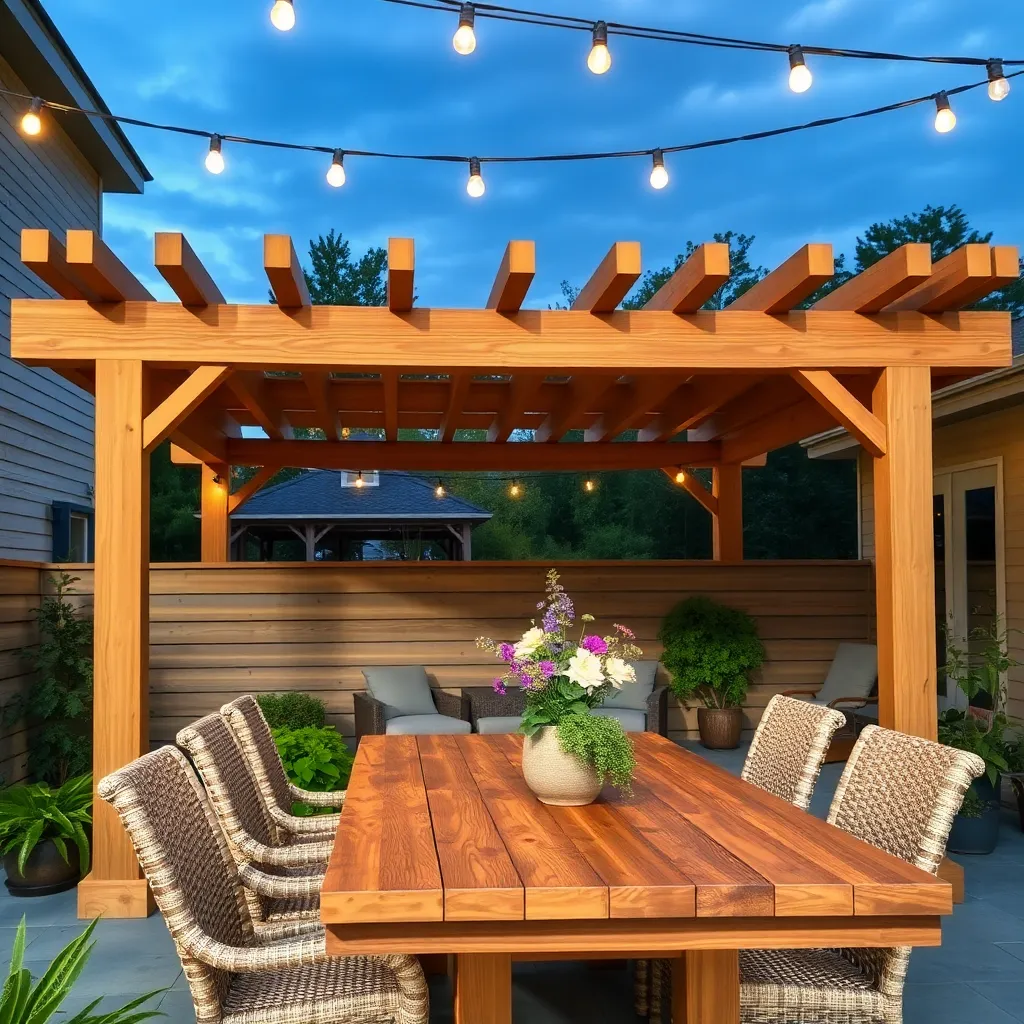
Creating a DIY pergola can transform your outdoor dining space, offering both style and function. Start by selecting durable materials like pressure-treated wood or cedar, known for their resilience against weather elements. Ensure the dimensions of your pergola align with your dining area; a standard size might be around 10×12 feet, but adjust as needed to fit your space. Secure your posts firmly in the ground using concrete for stability, and consider adding a cross-beam design for added support and visual interest.
For those looking to add a personal touch, consider integrating advanced features like a retractable canopy to provide shade or a string of solar-powered lights for ambiance. When designing your pergola, think about incorporating decorative details like lattice panels or climbing plants, which can enhance both privacy and aesthetics.
- Use galvanized hardware to prevent rust
- Sand the wood thoroughly to avoid splinters
- Consider pre-drilling holes to prevent wood from splitting
These small touches can elevate the look and feel of your pergola, making your outdoor dining area a true extension of your home.
Vertical Gardens on Pergolas
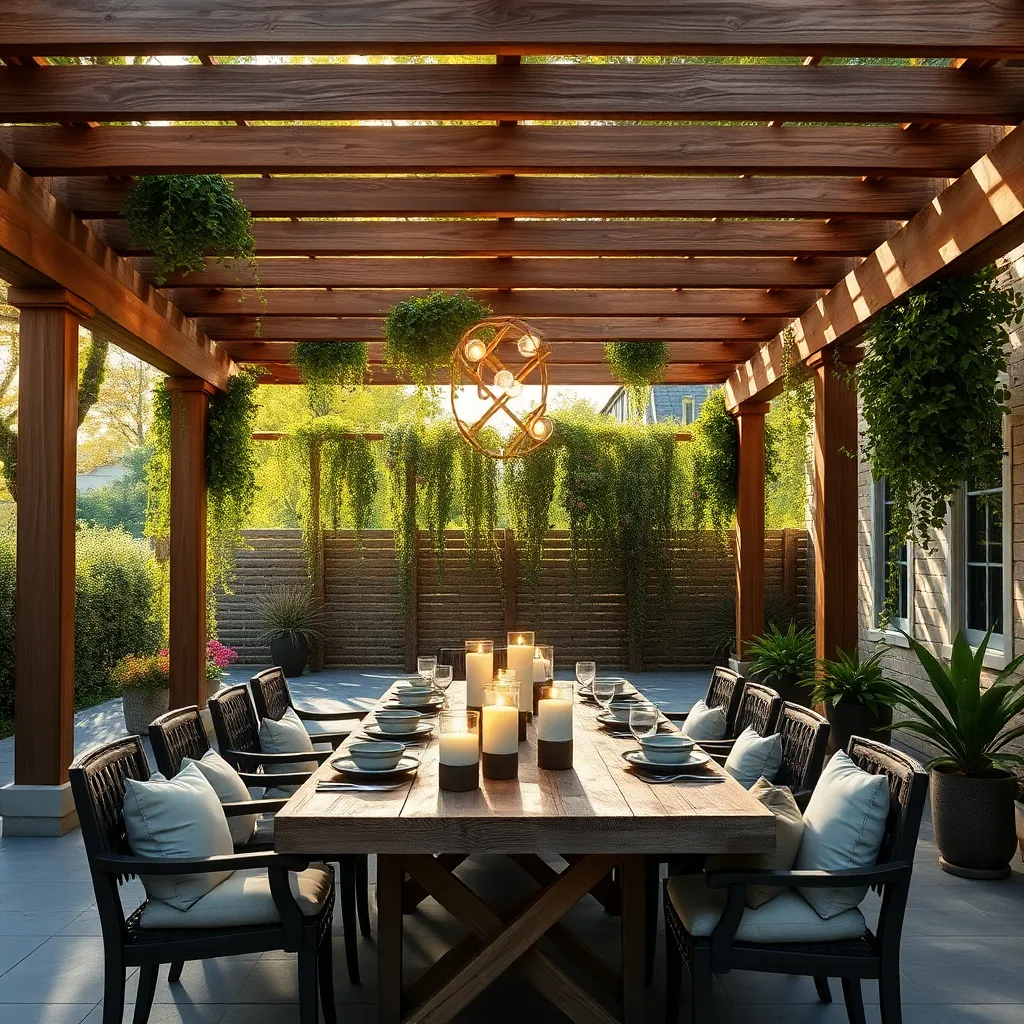
Transforming a pergola into a vertical garden can not only enhance aesthetics but also provide functional benefits like shade and privacy. Start by selecting durable materials such as cedar or pressure-treated wood for the pergola, which resist the elements and offer good support for climbing plants. Consider a variety of plants like jasmine, wisteria, or grapevines that thrive in your climate and grow well vertically. For beginners, using trellis panels or wire grids can help guide plant growth upward, creating a lush, green canopy.
For those more experienced in gardening, experiment with incorporating herbs or vegetables into your vertical garden, turning your pergola into a living pantry. Use sturdy containers or pockets attached to the pergola posts for smaller plants like strawberries or basil. Ensure proper irrigation by installing a drip system or using self-watering planters to maintain consistent moisture levels. This approach not only maximizes space but also offers a beautiful and functional dining area centerpiece, perfect for outdoor gatherings.
Enhancing Privacy with Pergolas
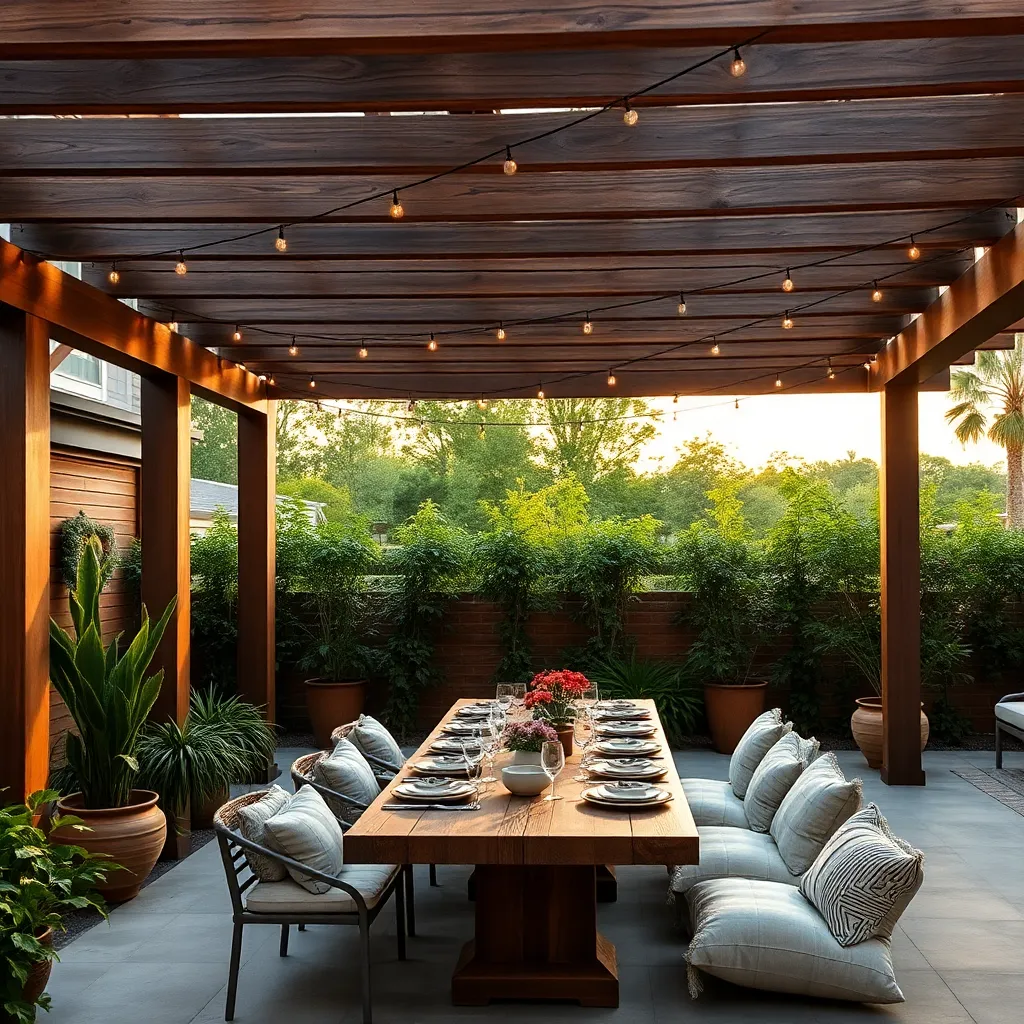
To enhance privacy with a pergola, consider incorporating side panels or drapes. These additions can be made from weather-resistant fabrics or natural materials like bamboo or reed, which add an organic touch. Mount curtains or bamboo screens on the sides of your pergola to create a more secluded dining area. Opt for adjustable panels that can be opened or closed depending on the level of privacy you desire.
For a more permanent solution, you can install latticework on one or more sides of the pergola. This not only offers privacy but also serves as a support for climbing plants, adding both greenery and coverage over time. Choose durable materials like cedar or redwood for the lattice, which are naturally resistant to decay. For advanced projects, consider integrating built-in planter boxes at the base of the lattice to encourage lush vine growth, enhancing both privacy and aesthetics.
Conclusion: Creating Beautiful Outdoor Spaces
In exploring the ’12 Pergola Designs for an Outdoor Dining Area,’ we discovered that each design reflects a unique facet of nurturing relationships: from the intimacy of cozy, enclosed spaces to the openness of airy, minimalist structures. These designs mirror essential relationship principles such as communication, flexibility, support, and balance. Whether it’s the classic charm of a vine-covered retreat or the modern appeal of sleek metallic frameworks, each pergola design offers a metaphor for creating spaces where relationships can thrive.
As your next step, consider how you can incorporate these relationship principles into your own life. Perhaps create a dedicated space for meaningful conversations or plan a special outdoor dinner to reconnect with loved ones.
I encourage you to bookmark this article for future reference; it’s a treasure trove of ideas and inspiration for nurturing the important relationships in your life. As you continue your journey towards relationship success, remember that each pergola design is a reminder of the beauty that comes from intentional connection and growth. Embrace these concepts, and watch your relationships flourish under the shelter of love and understanding.
